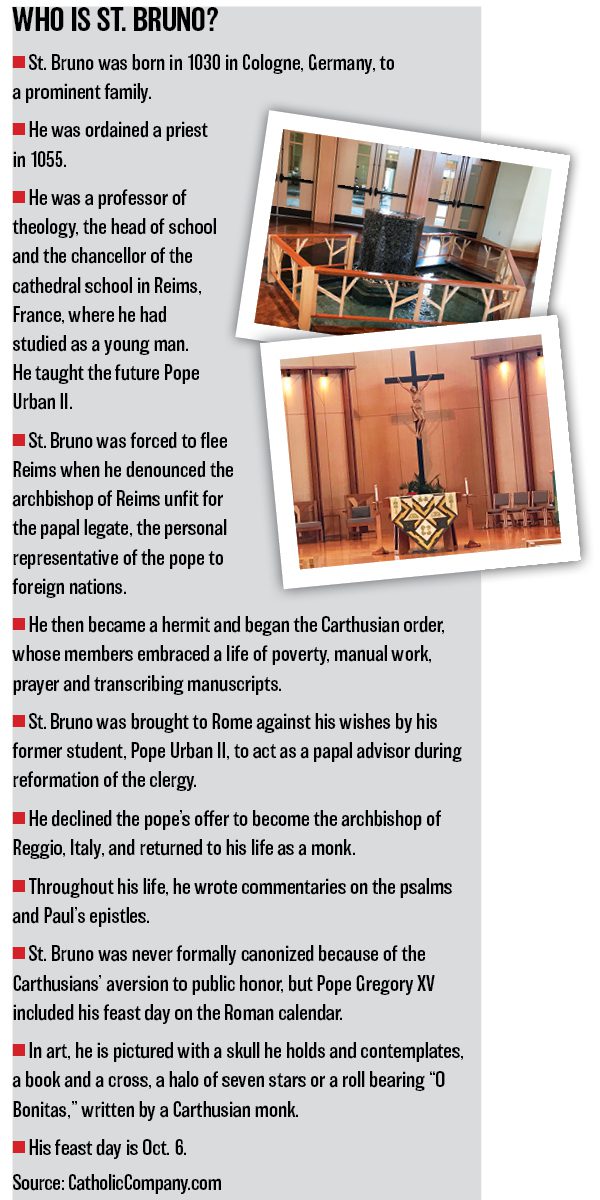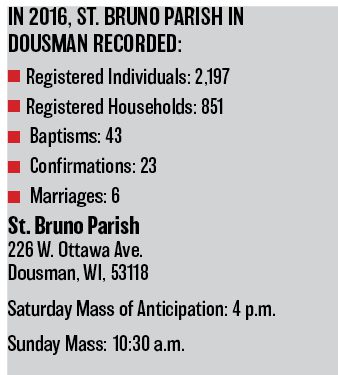When a fire destroyed a Dousman home last fall, the St. Bruno Parish community stepped up.

Top: The baptismal font located at the back of the church. Above: The altar at St. Bruno Parish in Dousman.
Parishioners filled an entire classroom with pots, pans, blankets and clothes within 24 hours of the event to give to the family who had lost their home.
“They have a wonderful spirit,” Fr. Dan Volkert, the administrator of St. Bruno Parish since June 2017, said. “If there’s a need, if there’s work that needs to be done, if there’s a family in need, immediately St. Bruno’s will respond to it.”
Volunteerism, service to others and to the Church is a strong thread that ties St. Bruno’s past and present together.
“The nucleus of people who are there and who do a lot of work are wonderful examples of what Jesus would say as giving your life to the Church,” said Jerry Strand, a long-time parishioner of St. Bruno and the father of Fr. Jacob Strand, Fr. Luke Strand and Fr. Vincent Strand, S.J. “The older generations sacrificed to build and keep things going. The ecumenism and evangelization is really powerful. It’s a strong place to be.”
The history of St. Bruno Parish is full of hard-working individuals who strived to make a place of worship to call their own. In the early 1840s, before Dousman was named a city, Fr. Martin Kundig visited the Ottawa mission and wrote many letters to Bishop John Martin Henni about the strong virtues of the area. The Link family, the ancestors of the Strand family, moved into the area in 1842. They were the founding members of the St. Bruno congregation.
St. Bruno Parish shares its early history with the St. Bruno mission church in Jefferson, built in 1846. Six years later, this church was enlarged and named St. Lawrence, but the people of Ottawa had a desire to build a church closer to home named St. Bruno. In 1854, Lawrence Link sold 2 acres of land to Bishop Henni for a German Roman Catholic church and cemetery. Link would donate 8 more acres of land to the church in the next two decades.
In 1854, a log church was constructed and priests from St. Lawrence in Jefferson would visit to celebrate the sacraments with the St. Bruno congregation. In 1865, St. Bruno became a parish with Fr. Lawrence Schreiner as its first residential pastor.
However, 20 years later, St. Mary Church in Sullivan became a parish, and St. Bruno became a mission of the parish, meaning the pastoral residence was at St. Mary, but the pastor would travel to St. Bruno to celebrate Mass and the sacraments. St. Bruno would remain a mission church until 1955.
While St. Bruno was still a mission church, a new brick church was built in 1887, which seated 110 people. In 1930, the people of St. Bruno received a letter from Archbishop Sebastian Messmer, who said a new, larger church should be built in Dousman.
In 1950, Frances Gramling donated 10 acres of land in Dousman for the building of a new church. Architects from Milwaukee drew plans and construction started on the project. A month before the groundbreaking, the archbishop postponed the building program indefinitely.
Archbishop Albert Meyer revived the building program in 1955, and Fr. Joseph Schliesmann became St. Bruno’s first pastor. The archbishop dedicated the new church and the school May 5, 1957. At that time, the parish had 103 families. The school would open four years later, in 1961.
Isidor and Emily Igl gifted the parish with 6 acres of land for the cemetery in 1958. Ten years later, they donated 2 more acres of land.
In 1969, Monsignor John Francis Murphy was appointed the pastor of St. Bruno parish, and was the first of many dynamic pastors of the parish. Other pastors included Fr. Donald Reiff, Fr. John Hanley, Fr. John Schreiter, and until recently, Fr. Ralph Gross.
The parish was becoming larger in the early 2000s and in 2002, land east of the parish was purchased. Ground for a new church was broken a year later. The renovations were completed in 2005 and Archbishop Timothy Dolan dedicated the new church March 6 of that year.

St. Bruno
St. Bruno Parish’s celebrated its 160th anniversary in 2012. At that time, the parish had 750 families.
The parish may have a number of families, but together, they are one big family. “St. Bruno is definitely a parish family, my family,” said Debbie Hendrick, a life-long member of the parish and the parish’s historian. “I love that everybody knows each other, and I love that many parishioners volunteer there.”
Many of those volunteers are involved in the parish’s hospitality, which is a vibrant aspect of the parish, according to Fr. Dan and its members. Before a visitor enters the parish doors, he or she is greeted by a Knights of Columbus member, who offers to park his or her car. The parish also hosts a hospitality weekend once a month, during which time food and fellowship is provided after each Mass. The Saturday evening Mass is followed by a dinner, and the Sunday morning Mass is followed by doughnuts, coffee and juice.
“Everybody is greeted over and over,” said Hendrick. “We are always watching out for new people to welcome them. When they join the parish, we give them special booklets with information. We really take them under our wing and get them involved in the parish. St. Bruno has always been that way.”
Not only does St. Bruno reach out to members in its own community, but they also reach out to members outside of the community. For years the parish had an outreach ministry to a vocational school in Guatemala, and the parish’s St. Vincent de Paul program is strong. 
“The parish reaches out to the poor and it’s just beautiful,” said Karen Warnes, who worked in ministry at the parish for 30 years, most recently as the pastoral associate. Warnes said she is proud of all of the people of the parish, especially those who have responded to vocations in the Church.
When Fr. Luke, Fr. Jacob and Fr. Vincent Strand were ordained in the last decade or so, they joined four other priests who were also previously parishioners at St. Bruno Parish. Five parishioners of the parish went on to religious life and four parishioners were ordained deacons.
St. Bruno is certainly a strong parish with faith-filled parishioners. It is placed on the western border of the Archdiocese of Milwaukee, and many say it embodies the uniqueness of the farming lifestyle and maintains the flavor of country living.
“We’re at the age now where people just don’t go to church,” said Jerry Strand. “If they knew what existed out there, they would be coming back to it. They would realize the fruition of what it would do. The leadership and the priests have been wonderful here; God has certainly blessed St. Bruno with good priests and good people who serve on the council. If people are looking for a place to come back to the Church, come on back (to St. Bruno). It’s a great place to be.”
